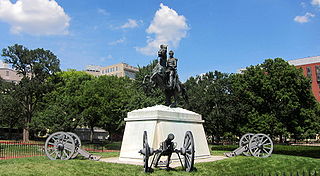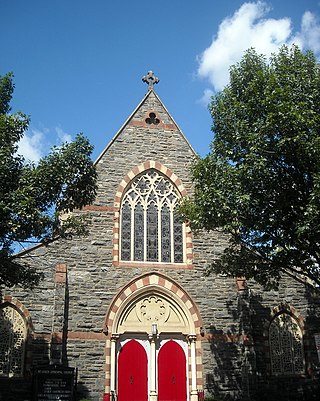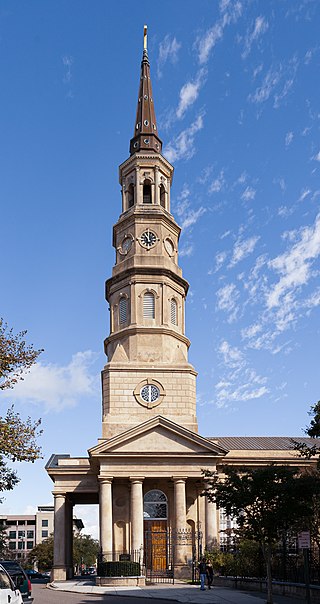
A clergy house is the residence, or former residence, of one or more priests or ministers of a given religion. Residences of this type can have a variety of names, such as manse, parsonage, rectory, or vicarage.

The Episcopal Diocese of Washington is a diocese of the Episcopal Church covering Washington, D.C., and nearby counties of Maryland in the United States. With a membership of over 38,000, the diocese is led by the Bishop of Washington, Mariann Budde. It is home to Washington National Cathedral, which is the seat of both the diocesan bishop and the Presiding Bishop of the Episcopal Church.

St. John's Episcopal Church, Lafayette Square is a historic Episcopal church located at Sixteenth Street and H Street NW, in Washington, D.C., along Black Lives Matter Plaza. The Greek Revival building, designed by Benjamin Henry Latrobe, is adjacent to Lafayette Square, one block from the White House. It is often called the "Church of the Presidents".

The Chester A. Arthur Home was the residence of the 21st president of the United States, Chester A. Arthur (1829–1886), both before and after his four years in Washington, D.C., while serving as vice president and then as president. It is located at 123 Lexington Avenue, between 28th and 29th Streets in Rose Hill, Manhattan, New York City. Arthur spent most of his adult life living in the residence. While Vice President, Arthur retreated to the house after the July 2, 1881 shooting of President James Garfield. Arthur was in residence here when Garfield died on September 19, and took the presidential oath of office in the building. A commemorative bronze plaque was placed inside the building in 1964 by the Native New Yorkers Historical Society and New York Life Insurance, and the house was designated a National Historic Landmark on January 12, 1965.

Christ Church is an Episcopal church in the Old City neighborhood of Philadelphia, Pennsylvania, United States. Founded in 1695 as a parish of the Church of England, it played an integral role in the founding of the Protestant Episcopal Church in the United States. In 1785, its rector, William White, became the first Presiding Bishop of the Episcopal Church.

Decatur House is a historic house museum at 748 Jackson Place in Washington, D.C., the capital of the United States. It is named after its first owner and occupant, the naval officer Stephen Decatur. The house is located at the northwest corner of Lafayette Square, at the southwest corner of Jackson Place and H Street, about a block from the White House.

The Lafayette Square Historic District is a National Historic Landmark District in Washington, D.C., encompassing a portion of the original L'Enfant Plan for the city's core. It includes the 7-acre (2.8 ha) Lafayette Square portion of President's Park, all of the buildings facing it except the White House, and the buildings flanking the White House to the east and west. The district was designated a National Historic Landmark in 1970.

The Cleveland Abbe House, also known as the Timothy Caldwell House and Monroe-Adams-Abbe House, is a historic house at 2017 "I" Street NW in Washington, D.C. Built in 1805, it is an excellent example of Federal period architecture. It has had a series of distinguished residents. Most notable are James Monroe, who occupied it as United States Secretary of War and as President of the United States while the White House was restored after the War of 1812, and historian Henry Adams. However, it was designated a National Historic Landmark in 1975 for its association with meteorologist Cleveland Abbe (1838–1916), the founder of the National Weather Service, who lived here from 1877 until his death. It is now home to the Arts Club of Washington.

Christ Church — known also as Christ Church, Washington Parish or Christ Church on Capitol Hill — is a historic Episcopal church located at 620 G Street SE in Washington, D.C., USA. The church is also called Christ Church, Navy Yard, because of its proximity to the Washington Navy Yard and the nearby U.S. Marine Barracks.

St. Luke's Episcopal Church is a historic Episcopal church located at 1514 15th Street, N.W., in Washington, D.C. Completed in 1879, it is home to the oldest African-American Episcopal congregation in the city. It was designated a U.S. National Historic Landmark in 1976 for its association with Rev. Alexander Crummell (1819–1898), a leading figure advocating black self-sufficiency and civil rights in the mid-19th century.

The Charleston, South Carolina, studio of sculptor Clark Mills, was his first—he worked there from 1837 to 1848, when he moved to Washington, DC. The Charleston studio was designated as a National Historic Landmark in 1965. Before it became Mills' studio, the building, located at 51 Broad Street, Charleston originally served as a tenement house, and now houses professional offices.

St. Michael's AnglicanChurch is a historic church and the oldest surviving religious structure in Charleston, South Carolina. It is located at Broad and Meeting streets on one of the Four Corners of Law, and represents ecclesiastical law. It was built in the 1750s by order of the South Carolina Assembly. It is listed on the National Register of Historic Places and is a National Historic Landmark.

The Colonel John Stuart House is a historic house at 104-106 Tradd Street in Charleston, South Carolina. Built in 1772, four years before the American Revolution, it is the city's oldest known example of a side-hall plan house. It is nationally significant as the home of Colonel John Stuart, who was the King's Superintendent of Indian Affairs in the South. He improved relations with the Five Civilized Tribes, especially the Cherokee Nation between the Seven Years' War and the American Revolutionary War. It was declared a National Historic Landmark in 1973.

St. Philip's Church is an historic church at 142 Church Street in Charleston, South Carolina. Its National Historic Landmark description states: "Built in 1836, this stuccoed brick church features an imposing tower designed in the Wren-Gibbs tradition. Three Tuscan pedimented porticoes contribute to this design to make a building of the highest quality and sophistication." On November 7, 1973, it was added to the National Register of Historic Places and designated a National Historic Landmark.

The American Peace Society House, also known as the Glover House, is a historic house at 734 Jackson Place NW, facing Lafayette Square in the heart of Washington, D.C. Built in 1878 for banker and philanthropist Charles Carroll Glover, it is most notable as the national headquarters of the American Peace Society from 1911 to 1948. The Peace Society was one of the first overtly pacifist organizations in the nation, with a history dating to 1815. The house was declared a National Historic Landmark in 1974.

The General Federation of Women's Clubs (GFWC) Headquarters, also known as the Miles Mansion, is located in Washington, D.C. Built as a private residence in 1875, it has served as the headquarters of GFWC since 1922. It was declared a National Historic Landmark in 1991 for its association with the federation, which serves as an umbrella organization for women's clubs, dating to the mid-19th century. Tours of the headquarters, available by appointment, provide information about the activities of the GFWC and several historic rooms, including the 1734 entryway, the Julia Ward Howe Drawing Room, the dining room, music room and the GFWC International President's office. The headquarters also features changing exhibits of art, photographs and artifacts from its collections.

The Peter Parker House, also known as the former headquarters of the Carnegie Endowment for International Peace, is a historic row house at 700 Jackson Place NW in Washington D.C. Built in 1860, it is historically significant for its association with the Carnegie Endowment, whose headquarters it was from its founding in 1910 until 1948. The building was declared a National Historic Landmark in 1974. It has since been incorporated into the Blair House complex serving high-profile official visitors to the capital.

Fort Kent, located at the confluence of the Fish and Saint John rivers in the town of Fort Kent, Maine, United States, is the only surviving American fortification built during the border tensions with neighboring New Brunswick known as the Aroostook War. It is preserved as the Fort Kent State Historic Site, which features an original log blockhouse that is open for visits in the summer. The fort was added to the National Register of Historic Places in 1969 and declared a National Historic Landmark in 1973.

St. Paul's Episcopal Church is a historic church building at Bridge Street and Vermont Route 14 in Royalton, Vermont. Built in 1836, it is a prominent early example of Gothic Revival architecture in the state, and is one of the oldest surviving public buildings in Royalton's historic village center. Now deconsecrated and maintained by the Royalton Historical Society, it was listed on the National Register of Historic Places in 2001.

Harris Hall is an auditorium located at 617 East Huron Street in Ann Arbor, Michigan. It was listed on the National Register of Historic Places in 1982.






















